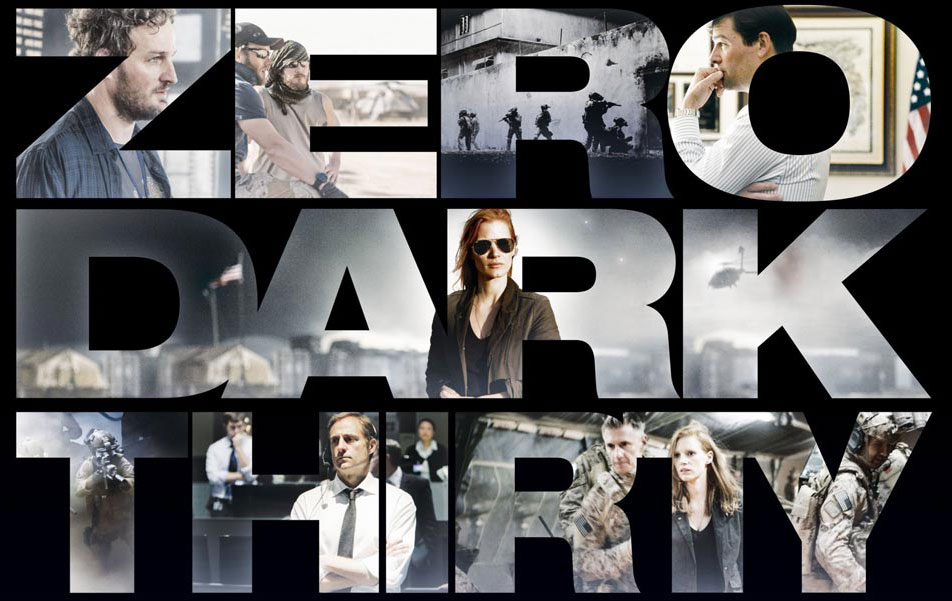
Zero Dark Thirty, the Oscar-nominated and critically acclaimed film by Kathryn Bigelow and Mark Boal, has been billed as ‘the story of history’s greatest manhunt for the world’s most dangerous man’. This hyperbole is not just typical of Hollywood, it is completely baseless. For one thing, Bin Laden is (or was) far from being the world’s most dangerous man. Even if he was actually responsible for all the acts of terror he has been accused of, then he would be a mass murderer but not on a scale even close to, for example, Vladimir Putin or Barack Obama. Indeed, the policy of drone strikes by Obama and Bush before him, have killed more people in Pakistan alone since 2004 than Bin Laden is alleged to have killed worldwide in his entire life [1]. The claim that Zero Dark Thirty tells ‘the story of history’s greatest manhunt’ is equally inaccurate and absurd. The range of information ignored by the film’s producers, in favour of a tedious narrative about a small group of CIA agents, warrants scrutiny.
 The film enjoyed a remarkable degree of official help in its production [2], most notably from the CIA’s Office of Public Affairs. While it wasn’t quite a bought and paid for production like the notorious 1954 CIA version of George Orwell’s Animal Farm, the collusion between the CIA and Boal and Bigelow means that in effect that distinction is meaningless. Emails released under a FOIA lawsuit show that the CIA were very much in favour of films about the Bin Laden story [3], and Bigelow and Boal’s proposed movie in particular. Marie E. Harf of the Office of Public Affairs wrote, ‘I know we don’t pick favorites but it makes sense to get behind a winning horse… Mark and Kathryn’s movie is going to be the first and the biggest. It’s got the most money behind it, and two Oscar winners on board.’
The film enjoyed a remarkable degree of official help in its production [2], most notably from the CIA’s Office of Public Affairs. While it wasn’t quite a bought and paid for production like the notorious 1954 CIA version of George Orwell’s Animal Farm, the collusion between the CIA and Boal and Bigelow means that in effect that distinction is meaningless. Emails released under a FOIA lawsuit show that the CIA were very much in favour of films about the Bin Laden story [3], and Bigelow and Boal’s proposed movie in particular. Marie E. Harf of the Office of Public Affairs wrote, ‘I know we don’t pick favorites but it makes sense to get behind a winning horse… Mark and Kathryn’s movie is going to be the first and the biggest. It’s got the most money behind it, and two Oscar winners on board.’
Another email about a meeting between Bigelow and acting director of the CIA (then deputy director) Michael Morrel details how, ‘Mr Morell gave them 40 minutes, talked some of the substance again, told them we’re here to help with whatever they need, and gushed to Kathryn about how much he loved ‘The Hurt Locker’.’ In turn, screenwriter Mark Boal, ‘agreed to share scripts and details about the movie with us, so we’re absolutely comfortable with what he will be showing.’ The filmmakers did not just have a vested interest in portraying the CIA in a good light, they simply agreed to make the film how the CIA wanted them to make it.
It comes as no surprise that the CIA are portrayed very well in the film, though the glorification of torture has led to criticism from both the mainstream press and the Agency itself. However, what the film doesn’t tell us is far more important than what it does tell us. The manhunt for Bin Laden is a much more complex story than the tale of coffee drinking and water boarding that makes up Zero Dark Thirty.
Our Man in the Sudan
In 1991 following the end of the Soviet war in Afghanistan, Bin Laden moved from Afghanistan to Sudan. He lived there for five years, dodging the occasional assassination attempt, while being closely monitored by Sudanese intelligence and developing his small network. Among those men involved in the fledgling Al Qaeda organisation was Jamal al-Fadl, a Sudanese militant who was one of the founding members of Al Qaeda in 1988 and was with Bin Laden from then until the mid-90s.

In the mid 1990s, after he embezzled over $100,000, al-Fadl had a falling out with Bin Laden and defected. He offered his services to the CIA who handed him over to Jack Cloonan and Dan Coleman, two FBI agents on secondment to the CIA’s Bin Laden unit. They encouraged him to move to the US and become a co-operator. From December 1996 onwards al-Fadl was holed up for three years in a safehouse, telling the FBI and CIA everything he knew about Bin Laden, his organisation, his motives and modus operandi.
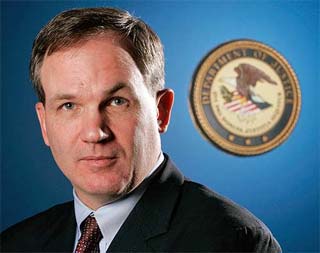 In early 2001, a few months before 9/11, al-Fadl was the key prosecution witness in the US vs Bin Laden et al trial, where several defendants and many more being tried in absentia (including Bin Laden) were accused of being members of the Al Qaeda organisation and of carrying out the 1998 embassy bombings. The prosecution was led by Patrick Fitzgerald, who had debriefed al-Fadl extensively. Fitzgerald also prosecuted the World Trade Center bombing trials, the case against the Blind Sheikh, and more recently the trial of Tahawwur Rana for his alleged involvement in the Mumbai massacre.
In early 2001, a few months before 9/11, al-Fadl was the key prosecution witness in the US vs Bin Laden et al trial, where several defendants and many more being tried in absentia (including Bin Laden) were accused of being members of the Al Qaeda organisation and of carrying out the 1998 embassy bombings. The prosecution was led by Patrick Fitzgerald, who had debriefed al-Fadl extensively. Fitzgerald also prosecuted the World Trade Center bombing trials, the case against the Blind Sheikh, and more recently the trial of Tahawwur Rana for his alleged involvement in the Mumbai massacre.
None of this made it into Zero Dark Thirty. As far as they were concerned the manhunt for Bin Laden only happened after 9/11, and so they didn’t care about al-Fadl or the only trial where Bin Laden was formally accused of anything. As a consequence they also overlooked the fact that years before 9/11 the US had requested help from the Sudanese government in their pursuit of Bin Laden.
In the period of March to May 1996, the US government made several requests for Sudan’s voluminous intelligence files on Bin Laden and his associates. This turned into a request that they turn over the man himself. The Sudanese government complied, offering their files and even offering up Bin Laden. Strangely the US government declined both of these offers, despite having requested the files and the man in the first place. Exactly what happened is not clear, and the 9/11 Commission claimed to have found no evidence that the Sudanese ever offered Bin Laden directly to the US. Nonetheless, there is abundant evidence that Sudan did offer their intelligence files [4], not just in 1996 but again in 1997, 1998 and 2000. The US intelligence agencies eventually accepted them, only weeks before 9/11.
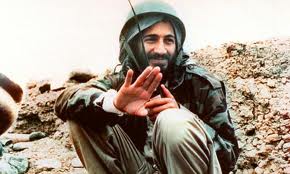 Regardless of whether the Bin Laden offer was ever made, why did they refuse the files? The CIA specifically requested them in early March 1996, according to a memo they handed over to their contact in the Sudanese government [5]. One possible reason is that the CIA had their own surveillance on Bin Laden in Sudan for at least some of his time there. According to his own autobiography, CIA contract agent Billy Waugh both spied on Bin Laden and helped train various Al Qaeda and related groups from 1989 onwards [6]. Did they even need the (presumably inferior) information held by Sudanese intelligence?
Regardless of whether the Bin Laden offer was ever made, why did they refuse the files? The CIA specifically requested them in early March 1996, according to a memo they handed over to their contact in the Sudanese government [5]. One possible reason is that the CIA had their own surveillance on Bin Laden in Sudan for at least some of his time there. According to his own autobiography, CIA contract agent Billy Waugh both spied on Bin Laden and helped train various Al Qaeda and related groups from 1989 onwards [6]. Did they even need the (presumably inferior) information held by Sudanese intelligence?
Alternatively, was it because of al-Fadl? At least some of Sudan’s intelligence came from him. According to al-Fadl’s testimony he had a contact in the Sudanese immigration and intelligence offices named Dr. Abdel Munim al Khabir [7]. With al-Fadl turning in 1996 and offering himself to the CIA, did they figure that he could tell them everything they needed to know?
Neither explanation is entirely satisfactory. The CIA wouldn’t have lost anything by supplementing their own surveillance and the information from al-Fadl with the Sudanese intelligence. Despite repeated efforts by Sudanese officials the files were refused year after year, until it was too late. This indicates that there was a deliberate effort to limit the amount of information the CIA had on Bin Laden in that period. What is certain is that when Sudan, under pressure from the US, expelled Bin Laden in 1996 the CIA and the US government in general did nothing to stop him returning to Afghanistan.
The ubiquitous Ali Mohamed
Zero Dark Thirty avoided the question of Sudan and al-Fadl by starting their story halfway through, much like the 9/11 Commission before them. The Commission ignored the relevance of Operation Cyclone – the CIA’s sponsorship of the mujahideen in Afghanistan in the 70s and 80s – and of how the Al Qaeda organisation grew out of that operation. Zero Dark Thirty simply ignored everything that happened before 9/11.
Instead, they told a story of the CIA struggling to get information and leads on Bin Laden’s whereabouts through the years following 9/11. In particular the CIA’s lack of human intelligence sources is shown to be a major problem. This comes to a head when the CIA becomes aware of a militant working as a double agent for Jordanian intelligence – Humam al-Balawi. The CIA attempt to recruit him as a triple agent but it goes horribly wrong when al-Balawi blows himself up in a CIA base in Afghanistan, killing himself and several CIA officers.
This is a very real event that happened at Forward Operating Base Chapman in Khost, Afghanistan in late 2009. At the time it was portrayed by the mainstream media as an example of how difficult it is for the CIA to get human intelligence sources from within terrorist groups, and this is the same basic narrative presented in Zero Dark Thirty. Just as with almost everything in the movie, this isn’t true.
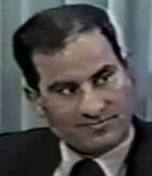 One man in particular was a top-notch source: Ali Mohamed. He was an Egyptian who joined the CIA during the 1980s and went on to serve in the US Special Forces and work as informant for the FBI in the 1990s. He was also a member of the Eyptian Islamic Jihad and Al Qaeda. He trained El Sayyid Nosair, the man who assassinated Rabbi Meir Kahane, along with many others at the Farouq mosque in Brooklyn where Jamal al-Fadl had first been inducted into Bin Laden’s circle. His trainees were ultimately responsible for the 1993 WTC bombing, the ‘Day of Terror’ plot in New York and the 1998 US embassy bombings in East Africa. Ali also trained Bin Laden’s bodyguards and numerous others in camps in half a dozen countries. He also ran the security for Bin Laden’s transfer from Sudan to Afghanistan in 1996.
One man in particular was a top-notch source: Ali Mohamed. He was an Egyptian who joined the CIA during the 1980s and went on to serve in the US Special Forces and work as informant for the FBI in the 1990s. He was also a member of the Eyptian Islamic Jihad and Al Qaeda. He trained El Sayyid Nosair, the man who assassinated Rabbi Meir Kahane, along with many others at the Farouq mosque in Brooklyn where Jamal al-Fadl had first been inducted into Bin Laden’s circle. His trainees were ultimately responsible for the 1993 WTC bombing, the ‘Day of Terror’ plot in New York and the 1998 US embassy bombings in East Africa. Ali also trained Bin Laden’s bodyguards and numerous others in camps in half a dozen countries. He also ran the security for Bin Laden’s transfer from Sudan to Afghanistan in 1996.
Despite this, Ali Mohamed was not arrested until September 1998, three years before 9/11 and several weeks after the embassy bombings. While his trainees were almost all prosecuted and many convicted, Ali was never called as a witness in any of the cases. Any of the cases, that is, except one. In the 1995 US vs Rahman et al trial of the Blind Sheikh and a group of his followers from the Farouq mosque the defence tried to call Ali Mohamed as a witness, on the assumption that his activities at the mosque were in some way officially sanctioned.
Ali never showed up, and never even responded to the witness subpoena. Court documents from the Ali Mohamed sourcebook indicate that he was explicitly told to ignore the subpoena and not turn up in New York and talk under oath about what he was doing [8]. The man who apparently told him to ignore the subpoena was none other than Patrick Fitzgerald, the leading attorney for the prosecution.
After his arrest in 1998 Ali ‘became’ a co-operator, and he was interrogated/debriefed by Jack Cloonan and Dan Coleman – the same men who handled Jamal al-Fadl’s defection. In October 2000 Ali pleaded guilty to a variety of terrorism charges, but he wasn’t used as a witness in the Bin Laden trial only a few months later. There is no record of him being sentenced and he has since disappeared.
‘How can we find UBL?’
Shortly after 9/11, while Ali Mohamed was still in the prison system, he wrote out a 30-page guide on Al Qaeda. According to Pete Blaber, a former Delta Force Commander and one of very few people to have ever seen this document it, ‘was a dissertation on how to find, infiltrate and defeat Al Qaeda in Afghanistan’.
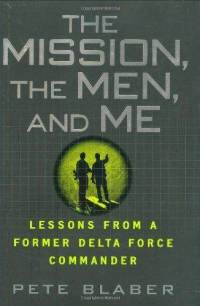 Blaber’s book The Mission, the Men, and Me Ali outlines how Mohamed’s guide even answered the question of ‘How can we find UBL?’ It said, ‘Look for his security detail. He trusts only a handful of men and they are the only ones who know where he is or where he will be. Don’t waste your time trying to find him: he is too careful. You will increase your odds tenfold if you focus on his ten closest security guards. You must do ‘police work’ here, learn where the guards’ families are and then focus your communication devices and surveillance on key members of those families. Then just wait for them to lead you back to Bin Laden.’
Blaber’s book The Mission, the Men, and Me Ali outlines how Mohamed’s guide even answered the question of ‘How can we find UBL?’ It said, ‘Look for his security detail. He trusts only a handful of men and they are the only ones who know where he is or where he will be. Don’t waste your time trying to find him: he is too careful. You will increase your odds tenfold if you focus on his ten closest security guards. You must do ‘police work’ here, learn where the guards’ families are and then focus your communication devices and surveillance on key members of those families. Then just wait for them to lead you back to Bin Laden.’
Blaber, who was part of the Delta Force commandos responsible for hunting Bin Laden in the Afghan-Pakistan border region, was so impressed by this guide that he shared it with his commanding officers and others in his unit. No one took it seriously. Blaber, trying to find out more, visited Ali in prison to question him further. The guide had finished with a note to the reader saying, ‘I am willing to assist the effort in any way required. I don’t believe in what Al Qaeda is doing, they are ruining the image of all Arabs and are doing great damage to the Arab cause throughout the world. I can find Bin Laden for you. I am only asking for a chance.’
When Blaber visited Ali he found an extremely intelligent, knowledgeable man who was more than willing to help the US find Bin Laden. ‘Take me with you to the Northwest Frontier Province, I can find him,’ he told Blaber. Ali went on to speak of his admiration for the CIA and the FBI and so convinced Blaber of his worth that the Delta Force man describes how he discussed with others in his unit the possibility of giving him his own covert blog to answer questions from soldiers on the ground in Afghanistan. He also outlines other ideas for deploying Ali in the early stages of the Afghanistan war in late 2001/early 2002. This included a variation on the movie Escape From New York, with Ali Mohamed in the Snake Plissken role, parachuted into Afghanistan to track down the big man.
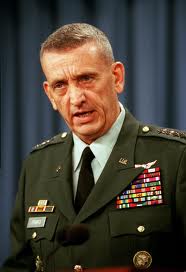 Ultimately, however, Ali Mohamed was not used to help find Bin Laden in Afghanistan in 2001/2. Even though Ali knew Bin Laden, knew his security standards, his habits, his likely movement, and even though Ali had trained Bin Laden’s cohorts in the very region where they were looking for him, he was not (at least officially) used in the manhunt. Why not? Is it because, as then commander in chief in Afghanistan Tommy Franks put it in October 2001 [9], ‘We have not said that Osama bin Laden is a target of this effort’? Or as US Chief of Staff Richard Myers said in April 2002 [10], ‘The goal has never been to get Bin Laden’?
Ultimately, however, Ali Mohamed was not used to help find Bin Laden in Afghanistan in 2001/2. Even though Ali knew Bin Laden, knew his security standards, his habits, his likely movement, and even though Ali had trained Bin Laden’s cohorts in the very region where they were looking for him, he was not (at least officially) used in the manhunt. Why not? Is it because, as then commander in chief in Afghanistan Tommy Franks put it in October 2001 [9], ‘We have not said that Osama bin Laden is a target of this effort’? Or as US Chief of Staff Richard Myers said in April 2002 [10], ‘The goal has never been to get Bin Laden’?
He who Controls the Past
Zero Dark Thirty ignored Ali Mohamed entirely, preferring instead to present the only spy inside Al Qaeda as a rogue agent suicide bomber. The existence of the likes of al-Fadl and Mohamed – highly credible, knowledgeable and co-operative sources of human intelligence both before and after 9/11 – was not part of the story the CIA wanted Boal and Bigelow to tell. All the information cited here was available in the public domain at the time of the ‘Bin Laden raid’ in Abbottabad in 2011 but rather than look at it, the makers of Zero Dark Thirty obviously preferred to have mutual flattery sessions with the CIA and DOD.
 This resulted in them telling a story of how the CIA’s torture program successfully yielded critical information (that they probably could have got from Mohamed or al-Fadl) that led them to the house in Abbottabad. While this pornographic celebration of torture has been criticised publicly for its inaccuracy, including by Michael Morrel, if Mark Boal was running his scripts past the CIA then they must have quietly approved of this tale, whatever they might say in public.
This resulted in them telling a story of how the CIA’s torture program successfully yielded critical information (that they probably could have got from Mohamed or al-Fadl) that led them to the house in Abbottabad. While this pornographic celebration of torture has been criticised publicly for its inaccuracy, including by Michael Morrel, if Mark Boal was running his scripts past the CIA then they must have quietly approved of this tale, whatever they might say in public.
After all, if the CIA are willing to feed a false story to filmmakers for the sake of their public image then there’s no reason for them to avoid jumping on the public bandwagon of criticism of the film they then went out and made. It is utterly two faced, but then the whole story in Zero Dark Thirty is willfully deceptive.
The CIA’s ‘failure’ to accept the offers of intelligence from Sudan, and their apparent ‘failure’ to exploit human sources like Ali Mohamed and Jamal al-Fadl in the wake of 9/11 illustrate a pattern of behaviour that we cannot ignore. These ‘failures’ should not simply be accepted, because they speak to a serious moral corruption in these most secretive of state institutions. The fact that they then lie to filmmakers, ‘failing’ to tell them about the original ‘failures’ and feeding them a nonsense story about the benefits of torture only confirms the damage being done by this moral corruption. However much money Zero Dark Thirty makes, however many awards it wins there is one simple thing we need to keep in mind: that it isn’t telling the truth.
____________________________________________________________
 Tom Secker is an independent researcher, who focuses on terrorism and the politics of fear. Tom runs the websites InvestigatingTheTerror.com and SpyCulture.com, and is a regular contributor to WideShut.co.uk
Tom Secker is an independent researcher, who focuses on terrorism and the politics of fear. Tom runs the websites InvestigatingTheTerror.com and SpyCulture.com, and is a regular contributor to WideShut.co.uk




